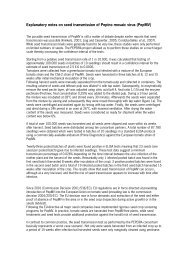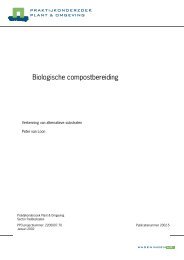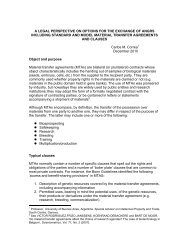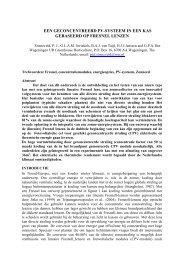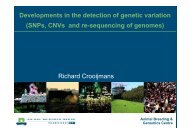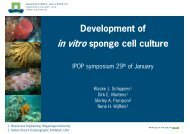Oil spill dispersant article
Oil spill dispersant article
Oil spill dispersant article
Create successful ePaper yourself
Turn your PDF publications into a flip-book with our unique Google optimized e-Paper software.
Impact of oil <strong>spill</strong>s on<br />
fisheries<br />
The fear that long-term<br />
damage to commercial<br />
fi sheries may result from<br />
the dispersion of <strong>spill</strong>ed oil<br />
is a recurrent theme in<br />
the <strong>dispersant</strong> debate. The<br />
possibility that the shortterm<br />
‘solution’ of using <strong>dispersant</strong>s<br />
to get rid of the<br />
more visible aspects of oil<br />
pollution, but that this may<br />
Fish farms can be<br />
pro-tected from some<br />
of the pollution by<br />
booming<br />
ultimately lead to a much more damage to<br />
fi sheries is a genuine concern that must be<br />
addressed.<br />
<strong>Oil</strong> <strong>spill</strong>s affect fi sheries even if <strong>dispersant</strong>s are<br />
not used. Experience from major oil <strong>spill</strong>s has<br />
shown that the possibility of long-term effects<br />
on wild fi sh stocks is remote. Adult fi sh swim<br />
away from <strong>spill</strong>ed oil; they can detect or ‘smell’<br />
the oil in the water and avoid it. Laboratory<br />
studies have shown that fish eggs and larvae<br />
are more likely to be affected than adult<br />
fi sh. However, fi sh produce vast numbers of<br />
eggs and larvae and these undergo very high<br />
mortality rates from processes other than oil<br />
<strong>spill</strong>s. The area, or volume, of sea in which<br />
elevated concentrations of dispersed oil or<br />
oil compounds will persist is very small compared<br />
to the size of fisheries.<br />
This means that, in almost all circumstances,<br />
the local fi sh population will be quickly<br />
replaced from other areas of the sea not<br />
affected by the oil <strong>spill</strong>. However, an oil <strong>spill</strong><br />
can cause loss of confi dence in the fi sh for<br />
sale, whether or not <strong>dispersant</strong>s are used. The<br />
public may be unwilling to purchase marine<br />
products from the affected area, irrespective<br />
of whether the seafood is actually tainted.<br />
Farmed fi sh and shellfi sh are more at risk<br />
from an oil <strong>spill</strong> than wild fish. The natural<br />
tendency of adult fi sh to avoid <strong>spill</strong>ed oil will<br />
be prevented in fi sh that are in cages. <strong>Oil</strong>ing<br />
of fi sh cages and other equipment may cause<br />
prolonged contamination of the fish or shellfi<br />
sh.<br />
Exposure and toxicity<br />
The concerns about the potential for toxic<br />
effects caused by dispersed oil, or toxic compounds<br />
liberated from dispersed oil, have generated<br />
many laboratory toxicity studies on<br />
the toxicity of oil and <strong>dispersant</strong>s. The results<br />
from these toxicity studies have been selectively<br />
quoted by both sides in the <strong>dispersant</strong><br />
debate to ‘prove’ particular views.<br />
As described earlier, toxic effects can be acute<br />
or chronic, lethal or sub-lethal. The toxic<br />
effects produced by a particular substance<br />
depend on the exposure an organism has<br />
to the substance. Exposure, in a toxicological<br />
sense, is a combination of:<br />
• Concentration of oil (as dispersed droplets<br />
or water-soluble components) to which the<br />
organism is exposed.<br />
• Duration of time for which the exposure<br />
persists<br />
Toxicity testing and predicting<br />
effects at sea<br />
In standard 96 hour LC50 toxicity test procedures,<br />
the test organisms are exposed to<br />
progressively higher concentrations of oil, <strong>dispersant</strong><br />
or oil and <strong>dispersant</strong> for 4 days (96<br />
hours). The concentration required to kill 50%<br />
of the test organisms is then calculated; hence<br />
the LC50 description (Lethal Concentration<br />
required to kill 50% of test animals). The<br />
results from 96 hour LC50 testing are useful<br />
indications of relative toxicity LC50 results do<br />
not give an indication of what might happen<br />
at sea because the exposure is for 4 days and<br />
the concentrations required to kill the test<br />
organisms is much higher than those in the<br />
sea.<br />
Early work concentrated on determining the<br />
toxicity of <strong>dispersant</strong>s using standard 96 hour<br />
LC50 methods. The next toxicity test strategy<br />
was to compare the effects of non-dispersed<br />
oil with dispersed oil. The results from these<br />
19



